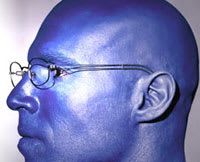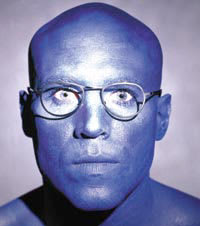|
|
|
|
Giorgio
Armani style AR1026 for Luxottica |
Silver Splendor
Beat the managed care blues by offering luxury eyewear
By Marcy Bruch
|
Photography by Daria Amato Makeup by Joe Murray Model: Michael Pape/ced Art Direction by Greg Mursko |
|
|
|
When you consider that consumers are willing to spend approximately $58 billion toward luxury goods each year, offering high-end eyewear that's not only functional but fashionable seems like an easy-to-win proposition. Furthermore, many optical retailers believe it's one of the best antidotes to offset shrinking margins because of managed care. It could even be a savior of lost business due to refractive surgery.
"Luxury eyewear represents the height of fashion and quality," maintains Barry Foss, owner of Facial Attire in Leonminster, Mass. "And even though it's still a medical necessity, it is marketed as a high-end accessory, which is the exact opposite way Lasik surgery is promoted." Still, Foss points out, "Some cars burn diesel fuel, but that doesn't mean gas stations that only offer gas will go out of business. Similarly, some people will opt to undergo Lasik surgery-the diesel option in our industry. But most people will want and need eyeglasses-the gas fuel of the business."
In fact, the reason Foss opened Facial Attire two years ago was to diversify his business in order to offset the decreasing margins he experienced at his other optical location, Lancaster Optical, due to the rise in managed care. "I wanted to offer the very best eyewear in my region to a customer base where managed care plans weren't an issue," says Foss.

|
|
|
Dolce & Gabbana style DG201 for Marcolin |
|
Jon Gruen, owner of six Gruen Optika stores in New York City and one in East Hampton, New York, shares the same philosophy. "I believe that eyewear is a medical device, but if people are willing to pay $1,500 to wear fine jewelry on their ears, why wouldn't they want to pay that much for something that is so much more obvious on their face?" asks Gruen.
Understand Fashion First
However, Gruen-who has been in business since 1971 and has an average retail ticket of $450-warns those who are thinking about jumping into the luxury arena to do their homework first.
"You have to educate yourself about fashion so that you are two steps ahead of the curve on everything. Because if you offer something that's out there now, it's already too late." That's why Gruen advises optical retailers to go to Europe and check out the big optical shows like Silmo in Paris and Mido in Milan.
In terms of fashion looks that are selling right now, Gruen says frames in natural materials like buffalo horn and wood are gaining popularity. "Thanks to modern technology, buffalo horn can remain moist through special waxes, making them more durable than before and less expensive," says Gruen. "I am selling buffalo horn lorgnettes that are truly works or art." Titanium and 22 karat gold plated frames are also selling well, he says. "Another big seller is any eyewear that features rhinestones or Swarovski crystals because they epitomize the image of luxury."
In fact, a number of optical retailers have observed that more people are looking to buy dressy eyewear to wear around the holidays. Michael King, owner of King Opticians in Warwick, R.I., says that he sold out of his gold and crystal Christian Dior frames over the holidays and sold one 18-karat gold plated Silhouette frame that totaled $1,200 with lenses and coatings. "Next year I will stock up more on dressier eyewear in anticipation of this holiday trend," he says.
|
|
|
|
Louis F.
L'Amy style LL01 for L'Amy |
The Exclusivity Factor
Alyce Skinner, owner of Adair Optical in Fort Worth, Texas, carries a number of jewelry-like frames but believes that in order to succeed in luxury eyewear you must have exclusivity on selected brands. "My customers know that if they want to get eyewear from Mikli, Caviar, or European-made product like Air Titanium, they have to come here because they won't find it anywhere else in this region," says Adair. "Your level of exclusivity is ultimately what sets you apart from your competition." Like Gruen, Adair reports that she is doing phenomenally well with any eyewear that has rhinestones and crystals. "Daniel Swarovski three-piece mount rimless styles are selling well, and so are Caviar gold-plated styles with rhinestones and Cartier platinum-plated frames." In men's eyewear, Adair says that she sells a lot of Air Titanium from Denmark as well as wood pieces and buffalo horn styles.
She also believes that offering high-fashion eyewear is the best way to combat the fallout of laser surgery. "The more high-fashion product you give people, the less they equate eyewear as a medical necessity. It conditions consumers to view eyewear as a true fashion accessory," she says.
Custom Counts
To raise the bar on exclusivity even more, Adair tries to customize eyewear as much as possible. For example, Adair fitted a leading Gospel minister who hosts a show on the BET station, Dr. Bobby Jones, with a Cartier platinum frame that included tinted green lenses. "To get exactly the right tint often means the loss of product because the color isn't always correct the first time around. But it's worth it because your customer will have a one-of-a-kind piece that's designed specifically to flatter his or her features."
Morgenthal-Frederics, which has four locations in New York City, also offers customized services such as modifying frame shapes and sandblasting certain areas of the frame for an unusual effect. "It's not necessarily the most important part of our business, but it does lend a certain amount of cach�," says co-owner Richard Morgenthal.
Skinner has even worked with jewelers to add crystals to frames for customized accents. "The frames are such statement pieces, my customers are like walking advertisements when they wear them and that invariably brings me more business."
Foss, of Facial Attire, agrees. "I always wear my most current and upscale product wherever I go," he says. "For example, I went to a party and three people asked me where I got my eyewear. Of course I gave them my business card and invited them to stop by." Gruen encourages his staff to wear current product as well. "Your staff members can be some of your most effective walking billboards," he maintains.

|
|
| Gucci style 1372 for S�filo |
|
Staff Sensibility
Beyond wearing the product, Gruen insists it's crucial to properly train personnel on luxury eyewear. "When you have multiple stores, the sales staff becomes your voice when you are absent," he says. "So first and foremost, they must believe in the product they are selling so that they gain a level of comfort presenting it.
"That means they have to understand why a product is worth the price. Which is why educating them is so important," he says. Still, Gruen admits that there are some people who have a degree of finesse in their ability to communicate and others who just don't. "It's important to hire the correct people who have that ability from the beginning because you can't make a silk purse out of a sow's ear."
Morgenthal has his staff members walk into upscale boutiques in the neighborhood to observe how other luxury product is presented. "At our Madison Avenue location, I have sales associates go into the H�rmes shop next door one by one to observe how the salespeople make presentations. Since our average ticket price is $475, it's important that our staff is able to sell high-end product guilt-free."
Regardless of how experienced your sales staff is, everyone agrees that it's important to show the highest-priced product first, and work down. "I sell to people who have good taste in eyewear, regardless of what kind of salary they make," insists Gruen. Adds Foss, "I just sold a woman a $600 pair of eyeglasses who wore clothes that were less than a $100. However, when I got her address for our files, I realized she lived in an affluent neighborhood. You would never have known it when she walked in the door." And that's an important point to keep in mind-always.
How Much Is Enough?
When it comes to properly showcasing luxury eyewear, Foss believes in selling narrow, but deep. In fact, he only carries two German-produced lines at Facial Attire: Cazal and Metzler. "Cazal is classic-yet-stunning eyewear with 18 karat or 22 karat gold plating, and Metzler caters to people who want eyewear that's a bit more funky," says Foss. All total, Facial Attire carries about 150 frames under these two brand names.
Morgenthal adds, "If you want to represent a collection and represent it well, you must carry a large assortment. Ten pieces don't do a collection justice. We're telling a fashion story as to why the collection is relevant, and giving consumers an insight into the designer's sensibility. To do that, you have to invest in fewer lines and buy bigger assortments. After all, you can't be all things to all people."
|
|
|
|
Style
Slick for l.a. Eyeworks |
Importance of Ambiance
One can't underestimate the power of the environment high-end product is sold in, either. "You can't sell Caviar frames out of a pushcart," asserts Morgenthal. "The consumer has to be set up for the sale the moment they walk in the door."
Because Morgenthal-Frederics stores are located in frenetically paced New York City, the stores are designed to project a soothing ambiance. "There's not a barrage of posters and point-of-purchase materials all over to distract their attention. There's not even a lot of product displayed," points out Morgenthal. "Instead, lights throw off an incandescent glow, and we play soft music like jazz to get customers into a calmer state of mind." The reasoning behind this is so customers can better focus on the product in an environment where it's easy to make decisions. The store even has custom-made lampshades and tabletops that are made with the same zyl material that is on the eyewear that is merchandised.
Adds Gruen, "You have to design your store the same way a fashion boutique is decorated. And that means merchandising eyewear by theme or color so the consumer understands the product first and foremost as fashion."
He concludes: "If you're selling luxury eyewear, and doing it well, the biggest asset you will have is your competition. Because when people in the neighborhood see tired-looking product on dusty shelves somewhere down the road, and then come to your location to buy, there is no competition."
EB
|
|
|
How to Succeed In the Luxury Market |
|
1. Educate yourself about fashion: Go to shows like Silmo in Paris and Mido in Milan. That way you are two steps ahead of the curve when it comes to fashion trends. 2. Try to be exclusive in your area: Exclusivity in a brand gives you the edge over your competition. It also strengthens your niche. 3. Buy narrow and deep: Five styles in each line doesn't create adequate fashion impact. You must offer a large assortment of a brand. Create a headquarters concept. 4. Hire the right people: Make sure your staff exudes an upscale image. It adds to your credibility as a purveyor of luxury product. 5. Create an upscale environment. The d�cor of your retail location conveys to customers what kind of product you sell. 6. Train your staff: They must believe in the product they are selling and know features and benefits cold. 7. Sell top down to everyone: Don't prejudge a customer by how they appear. Only the customer knows what they are willing to spend, so don't make assumptions. 8. Offer customized features: Custom tints and embellished accents give customers an opportunity to own one-of-kind eyewear which further reinforces your reputation for offering exclusive product. |






